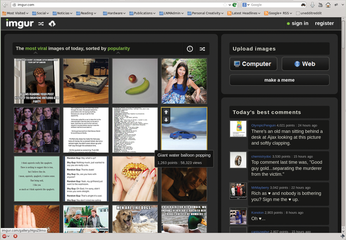Anonymous media sharing with MediaCrush
Up to Speed

Sharing videos or images doesn't always require a full-fledged YouTube or Flickr clone. Sometimes all you want is a quick place to upload, so you can link to your media or share it online. MediaCrush gives you just that, as well as other interesting perks.
MediaCrush [1] is not a Flickr, YouTube, or SoundCloud stand-in, nor is it meant to be. If that's what you need, check out MediaGoblin, which I talked about in a previous article [2]. MediaCrush works more like Imgur [3], which allows you to upload images quickly and easily – with no registration required (Figure 1).
Like Imgur, MediaCrush (Figure 2) does not require registration, and it is absurdly simple to upload images to the site. The main aim of the site is to provide links or code snippets for embedding your media elsewhere. It was originally developed specifically for Reddit and is 100% RES (Reddit Enhanced Suite) compatible [4].
[...]
Buy this article as PDF
(incl. VAT)
Buy Linux Magazine
Subscribe to our Linux Newsletters
Find Linux and Open Source Jobs
Subscribe to our ADMIN Newsletters
Support Our Work
Linux Magazine content is made possible with support from readers like you. Please consider contributing when you’ve found an article to be beneficial.

News
-
Two New Distros Adopt Enlightenment
MX Moksha and AV Linux 25 join ranks with Bodhi Linux and embrace the Enlightenment desktop.
-
Solus Linux 4.8 Removes Python 2
Solus Linux 4.8 has been released with the latest Linux kernel, updated desktops, and a key removal.
-
Zorin OS 18 Hits over a Million Downloads
If you doubt Linux isn't gaining popularity, you only have to look at Zorin OS's download numbers.
-
TUXEDO Computers Scraps Snapdragon X1E-Based Laptop
Due to issues with a Snapdragon CPU, TUXEDO Computers has cancelled its plans to release a laptop based on this elite hardware.
-
Debian Unleashes Debian Libre Live
Debian Libre Live keeps your machine free of proprietary software.
-
Valve Announces Pending Release of Steam Machine
Shout it to the heavens: Steam Machine, powered by Linux, is set to arrive in 2026.
-
Happy Birthday, ADMIN Magazine!
ADMIN is celebrating its 15th anniversary with issue #90.
-
Another Linux Malware Discovered
Russian hackers use Hyper-V to hide malware within Linux virtual machines.
-
TUXEDO Computers Announces a New InfinityBook
TUXEDO Computers is at it again with a new InfinityBook that will meet your professional and gaming needs.
-
SUSE Dives into the Agentic AI Pool
SUSE becomes the first open source company to adopt agentic AI with SUSE Enterprise Linux 16.


